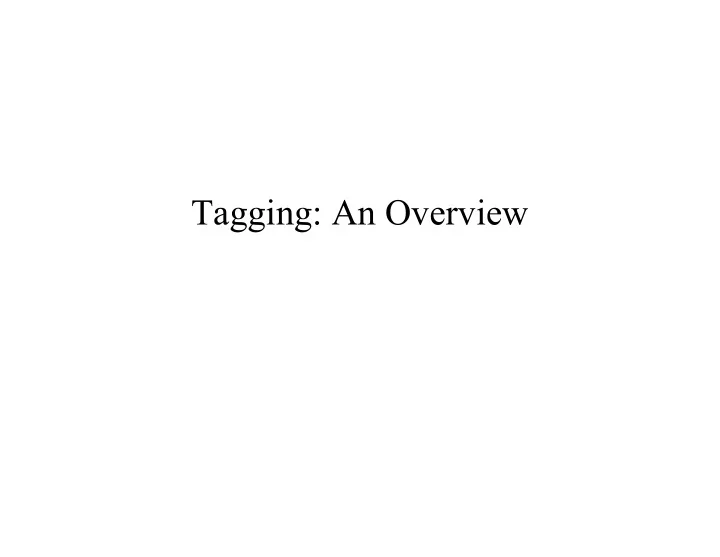

Tagging: An Overview
Rule-based Disambiguation • Example after-morphology data (using Penn tagset): I watch a fly . NN NN DT NN . PRP VB NN VB VBP VBP • Rules using – word forms, from context & current position – tags, from context and current position – tag sets, from context and current position – combinations thereof 2018/2019 UFAL MFF UK NPFL068/Intro to statistical NLP II/Jan Hajic and Pavel Pecina 24
Example Rules I watch a fly • If-then style: NN NN DT NN PRP VB NN VB • DT eq,-1,Tag VBP VBP (implies NN in,0,Set as a condition) • PRP eq,-1,Tag and DT eq,+1,Tag VBP • {DT,NN} sub,0,Set DT • {VB,VBZ,VBP,VBD,VBG} inc,+1,Tag not DT • Regular expressions: • not (<*,*,DT not • not (<*,*,PRP>,<*,*, not VBP>,<*,*,DT>) • not (<*,{DT,NN} sub, not DT • not (<*,*,DT>,<*,*,{VB,VBZ,VBP,VBD,VBG}>) 2018/2019 UFAL MFF UK NPFL068/Intro to statistical NLP II/Jan Hajic and Pavel Pecina 25
Implementation • Finite State Automata – parallel (each rule ~ automaton); • algorithm: keep all paths which cause all automata say yes – compile into single FSA (intersection) • Algorithm: – a version of Viterbi search, but: • no probabilities (“categorical” rules) • multiple input: – keep track of all possible paths 2018/2019 UFAL MFF UK NPFL068/Intro to statistical NLP II/Jan Hajic and Pavel Pecina 26
Example: the FSA • R1: not (<*,*,DT not • R2: not (<*,*,PRP>,<*,*, not VBP>,<*,*,DT>) • R3: not (<*,{DT,NN} sub, DT • R4: not (<*,*,DT>,<*,*,{VB,VBZ,VBP,VBD,VBG}>) • R1: anything <*,*,DT not anything F1 N3 F2 else anything else • R3: anything <*,{DT,NN} sub , not DT anything F1 N2 else 2018/2019 UFAL MFF UK NPFL068/Intro to statistical NLP II/Jan Hajic and Pavel Pecina 27
Applying the FSA I watch a f NN NN DT N PRP VB NN V VBP V • R1: not (<*,*,DT not • R2: not (<*,*,PRP>,<*,*, not VBP>,<*,*,DT>) • R3: not (<*,{DT,NN} sub, DT • R4: not (<*,*,DT>,<*,*,{VB,VBZ,VBP,VBD,VBG}>) • R1 blocks: remains: or a fly a fly a fly DT NN NN DT NN VB VB VBP VBP • R2 blocks: remains e.g.: and more I watch a I watch a NN DT DT PRP VB PRP VBP • R3 blocks: remains only: a a • R4 R1! DT NN 2018/2019 UFAL MFF UK NPFL068/Intro to statistical NLP II/Jan Hajic and Pavel Pecina 28
Applying the FSA (Cont.) I watch a fly NN NN DT NN PRP VB NN VB VBP VBP • Combine: a fly a fly DT NN NN NN VB VBP I watch a DT PRP VBP a DT • Result: I watch a fly . PRP VBP DT NN . 2018/2019 UFAL MFF UK NPFL068/Intro to statistical NLP II/Jan Hajic and Pavel Pecina 29
Tagging by Parsing • Build a parse tree from the multiple input: S VP NP I watch a fly NN NN DT NN PRP VB NN VB VBP VBP • Track down rules: e.g., NP DT NN: extract (a/DT fly/NN) • More difficult than tagging itself; results mixed 2018/2019 UFAL MFF UK NPFL068/Intro to statistical NLP II/Jan Hajic and Pavel Pecina 30
Statistical Methods (Overview) • “Probabilistic”: • HMM – Merialdo and many more (XLT) • Maximum Entropy – DellaPietra et al., Ratnaparkhi, and others • Rule-based: • TBEDL (Transformation Based, Error Driven Learning) – Brill’s tagger • Example-based – Daelemans, Zavrel, others • Feature-based (inflective languages) • Classifier Combination (Brill’s ideas) 2018/2019 UFAL MFF UK NPFL068/Intro to statistical NLP II/Jan Hajic and Pavel Pecina 31
Recommend
More recommend